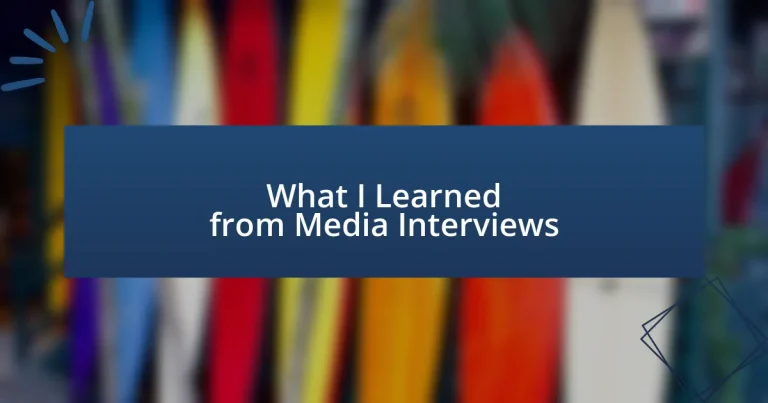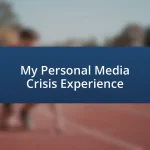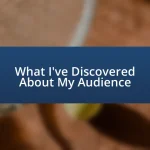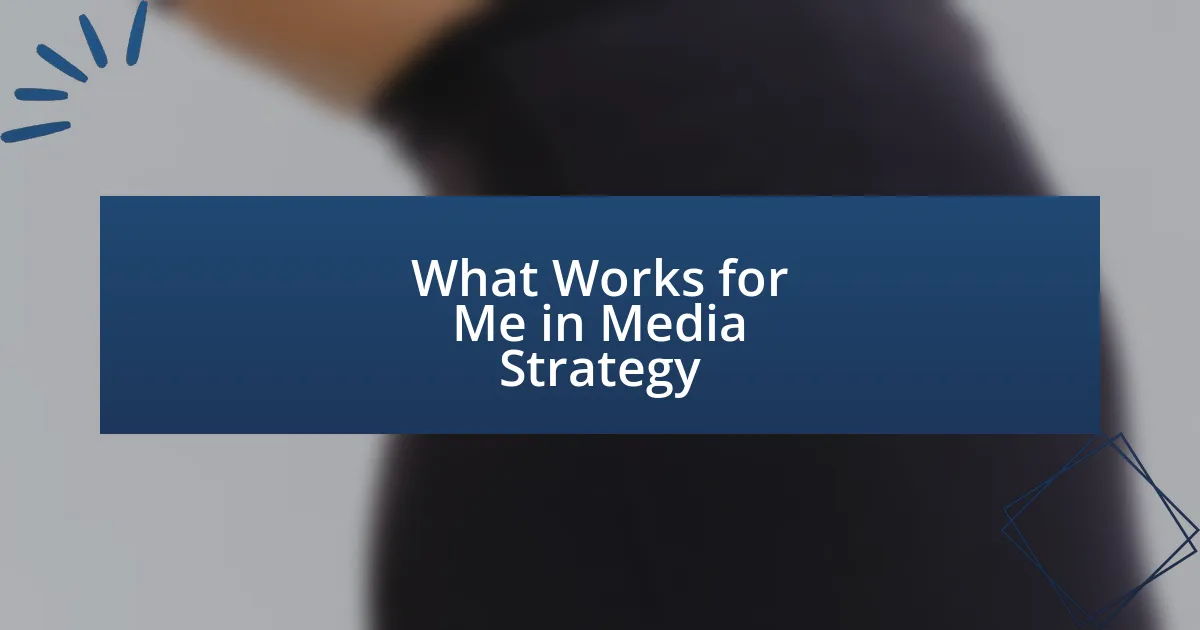Key takeaways:
- Preparation is essential for successful media interviews; understanding your key messages boosts confidence and improves conversation flow.
- Effective communication techniques include “bridging” to stay on topic, using visuals to simplify complex ideas, and practicing active listening to build rapport.
- Managing anxiety through deep breathing and visualization can transform interview experiences, helping to channel nerves into positive energy.
- Feedback is a valuable tool for growth; reflecting on it can uncover patterns for improvement in communication style and delivery.

Understanding Media Interviews
Media interviews serve as a powerful platform for individuals to share their stories, experiences, and insights. From my own experience, stepping into an interview can feel like standing on a precipice—exhilarating yet daunting. I often find myself wondering, how can I convey my message authentically while still being engaging?
I’ve learned that understanding the dynamic of an interview is crucial. It’s not just about answering questions; it’s about connecting with the audience and the interviewer. One time, I was asked an unexpected question that forced me to reflect deeply. It revealed to me how a single moment of vulnerability can resonate more than a scripted response.
Moreover, the environment of a media interview plays a significant role in shaping the conversation. I remember an interview setting that felt more like a casual chat over coffee. It made me feel at ease and allowed my personality to shine through. Have you ever noticed how comfortable surroundings can really influence the way you present yourself?

Importance of Preparation
Preparation is the backbone of any successful media interview. I’ve experienced firsthand the difference it makes—I once walked into an interview without much prep and stumbled through a few questions. It felt like jogging uphill, while my more prepared peers glided through effortlessly. I realized that knowing my key messages inside and out not only boosts my confidence but also elevates the entire conversation.
Here are some essential preparation tips that I swear by:
- Research the interviewer’s previous work to anticipate their style and questions.
- Practice key messages to articulate them smoothly, even under pressure.
- Prepare anecdotes that highlight your main points for a more engaging discussion.
- Familiarize yourself with the media outlet’s audience to tailor your responses.
- Create a list of potential questions to help you prepare for the unexpected.
Each of these steps has made me more resilient and adaptable, helping to turn the interview into a positive experience.

Key Techniques for Effective Responses
Effective communication during media interviews is paramount. One technique that I strongly endorse is using the “bridging” method. This involves steering the conversation back to your key messages, even if the interviewer asks something off-topic. I remember one occasion where I was asked a tricky question about a controversial topic. Instead of getting flustered, I calmly acknowledged it and pivoted back to my main message about community engagement. It not only salvaged the interview but also reinforced my points effectively.
Using visuals can also enhance understanding during your responses. I often utilize simple metaphors or visual comparisons to clarify complex ideas. In one interview, I explained statistical data by comparing it to everyday experiences, like the number of books on a shelf. This approach transformed abstract figures into relatable concepts, making my message stick with the audience.
Finally, practicing active listening is essential. Engaging with the interviewer by nodding or paraphrasing their questions helps to build rapport. I found that by reflecting back parts of their questions, it made them feel heard and allowed me to tailor my responses more effectively. It leads to a natural dialogue, making the whole interview seem less like a Q&A and more like a conversation.
| Technique | Description |
|---|---|
| Bridging | Redirecting conversation back to key messages, even if asked challenging questions. |
| Using Visuals | Employing metaphors or relatable examples to simplify complex information. |
| Active Listening | Engaging with the interviewer by paraphrasing and acknowledging their questions. |

Managing On-Air Anxiety
Managing anxiety on-air is a challenge many of us face, and I’ve learned it’s crucial to embrace those nerves rather than fight them. I once walked into a live interview feeling a wave of anxiety wash over me. Instead of succumbing to fear, I took a deep breath, acknowledged my feelings, and reminded myself that those sensations were a natural response to being in the spotlight. This shift in mindset helped me focus on delivering my message rather than worrying about how I appeared.
Something that has really worked for me is visualization techniques. Before stepping into an interview, I often picture myself in a calm and collected state, confidently sharing my ideas. There was a moment where I envisioned the audience smiling and nodding along as I spoke, and it transformed my experience. This mental preparation helped ground me, making it easier to channel that initial anxiety into positive energy.
Another effective strategy involves practicing short, focused breathing exercises. I remember one particular interview where I felt my heart racing just moments before going live. I quickly took a few seconds to breathe deeply and center myself. It may sound simple, but that small act made a significant difference, allowing me to transmit calmness not only to myself but also to the viewers. Have you ever tried breathing techniques before a stressful moment? They can truly be a game-changer.

Building a Strong Personal Brand
Building a strong personal brand is essential in today’s media-driven world. I remember a time when I was invited to speak on a panel, and I realized that my personal brand wasn’t just about my achievements; it was about how I presented myself and my values. Crafting my narrative involved reflecting on what made me unique and aligning that with how I wanted others to perceive me. This self-awareness helped shape the way I communicated, both on and off the screen, creating a consistent image that resonated with my audience.
In my experience, authenticity plays a huge role in personal branding. When I first started doing interviews, I sometimes felt pressured to fit into a certain mold. However, I found that the moments I truly connected with viewers were when I shared my genuine thoughts and experiences. For instance, during one interview, I shared my personal journey of overcoming challenges, and the positive feedback I received was overwhelming. Have you ever felt that connection when being your true self? It’s incredibly powerful.
Moreover, I learned that consistency is key. I found that maintaining a cohesive message across various platforms—whether that’s social media, interviews, or networking events—reinforced my brand. There was a time when I posted regularly about my insights on my blog, which helped solidify my standing as an expert in my field. The more I showed up authentically and regularly, the stronger my personal brand became. Think about your own contributions—how can you showcase your unique voice in a consistent manner?

Learning from Interview Feedback
Receiving feedback after interviews has been a pivotal part of my growth. I remember a time when a journalist pointed out that my responses at times lacked depth. Initially, I felt defensive, but I decided to take a step back and reflect. That moment taught me the importance of not just answering questions, but also elaborating on my thoughts to provide a richer experience for the audience. Have you ever had feedback that stung at first but later proved to be invaluable? It’s these insights that can truly shape our future interactions.
Every piece of feedback has been a lesson in itself. During one interview, I noticed a subtle comment about my pacing. It made me realize that while I was focused on what I wanted to say, I was unintentionally rushing through my points. Since then, I’ve made a conscious effort to slow down, allowing my thoughts to resonate. This adjustment transformed my delivery and made me more relatable. How often do we need to pause and rethink our approach based on feedback?
Over time, I discovered that feedback isn’t just criticism; it’s a treasure trove of opportunities for improvement. After a particularly challenging interview, I conducted a self-assessment. I listed feedback points alongside my reflections, and the process unraveled a pattern of areas that needed attention. This method not only provided clarity but also empowered me to address those weak spots strategically. I encourage you to try this—what patterns might emerge from your own feedback?

Strategies for Future Interviews
One strategy I found effective for future interviews is to prepare a list of key points I want to convey beforehand. During one of my more challenging interviews, I realized I often forgot to mention crucial aspects of my experience. By jotting down my main points, I began to feel a sense of control over the conversation, reducing anxiety and allowing my passion for the topic to shine through. How do you ensure your voice is heard in an interview?
Another approach I’ve adopted is practicing active listening. I recall a moment when a reporter asked me an unexpected question, and instead of fully grasping it, I rushed into an answer. This not only led to a miscommunication but also left me frustrated afterward. By actively listening, I’ve learned to take pauses, reflect, and respond thoughtfully, making the exchange feel more authentic and engaging. How often do you check in with your mindset during interviews?
Lastly, I cannot overstate the benefit of recording practice sessions. This simple act transformed my perspective on my delivery style. I once recorded myself, and upon reviewing, I noticed habits I wasn’t aware of, like fidgeting or too much filler language. By confronting those habits head-on, I tailored my approach for future interviews, creating a more polished and confident presence. What discoveries do you think could come from recording your own practice?





